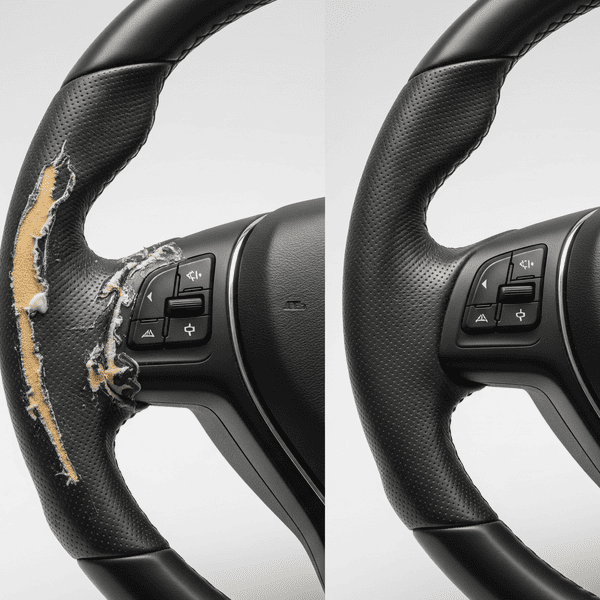
Your leather steering wheel is the one part of your car you touch every time you drive. Over time, it naturally wears out—scratches, fading, or even cracks. Many car owners try to fix leather steering wheel damage themselves using DIY kits they find online. But does it actually work?
As professionals who specialize in leather restoration in San Diego, we’ve seen it all. Today, we’ll share why quick fixes often make things worse and what really restores your steering wheel to a like-new look that lasts.
Steering wheels go through more wear and tear than you might expect:
Constant contact with skin oils, sweat, and sanitizers
Sun exposure through the windshield
Temperature changes
Leather on the wheel is thinner and more sensitive than on car seats or furniture. That’s why leather steering wheel restoration requires precision, not just a paint job.
Let’s talk about what we’ve seen from real cars brought to us after a failed DIY attempt.
These often come with filler, dye, and a sponge. On paper, it sounds promising. In practice:
The color doesn’t match (we’ve seen bright orange-brown wheels on black interiors)
The dye peels off within weeks
Filler cracks or hardens, making the wheel feel rough and stiff
Pro tip from experience: many of these kits are designed for furniture or jackets, not high-touch surfaces like a steering wheel.
This one is common. A client once used shoe polish to cover up faded leather. It bled onto their hands in the summer heat.
Super glue is even worse—it stiffens the leather and creates visible patches that are nearly impossible to remove later.
We’ve had clients try to rewrap their steering wheels using faux leather or universal covers. While this hides the problem, it:
Looks bulky and cheap
Can be dangerous (slipping or shifting during driving)
Often traps moisture, worsening the damage underneath
We use a different approach—and it shows in both durability and look. Here’s what sets professional service apart:
Not every wheel needs the same fix. Some need cleaning and recoloring, others need crack filler or full reconditioning.
We always start with an honest evaluation. Sometimes the leather is too dry or torn for a lasting result, and we recommend reupholstery instead.
This step is key. We use color-matching techniques to blend the dye into the existing tone. No orange tints or patchy results.
We even keep notes and photos of leather tones used for returning clients or touch-ups.
Our products are made for automotive use and designed to last:
UV protection
Heat resistance
Flexible finish that doesn’t crack or peel
Clients often tell us: “This looks better than when I bought the car!”
Every vehicle is different. For example:
BMW wheels have softer, matte finishes
Lexus often uses perforated leather
Classic cars may have vintage grain patterns
We’ve worked on them all, and we know how to keep the original look intact.
Here are just a few stories from our local clients:
This wheel was dry, discolored, and scratched near the top. The owner had tried a home polish but made it greasy and sticky.
We:
Cleaned the surface with pH-neutral leather cleaner
Applied custom color-match dye
Sealed with matte finisher
Result: A clean, even-toned wheel that felt smooth and grippy.
This was a rare collector’s car. The owner wanted it to stay as original as possible.
We:
Filled minor cracks with flexible compound
Recolored only the affected zones to preserve the patina
Note: Sometimes less is more. Restoration doesn’t always mean making it look brand new—it’s about preserving value.
This one had uneven dye stains and a rough texture due to a cheap kit. We had to:
Strip off the incorrect dye
Sand and refinish the leather
Build up layers of professional-grade color and topcoat
Lesson: Fixing DIY mistakes takes twice the time—and often costs more.
Here’s what to watch for:
Visible cracks or scratches
Fading or discoloration
Stickiness or peeling
Uneven texture or roughness
If your hands are sticking to the wheel in the heat, or it feels like sandpaper, it’s time to restore.
The sooner you address the issue, the better. Deep cracks can reach the foam underneath and require full reupholstery.
Prices vary based on:
Level of damage
Car model
Finish and texture
But in general, steering wheel restoration in San Diego ranges $150+ for standard cases.
We always offer a free assessment first. And for regular clients, we keep a record of colors and finishes to make future touch-ups fast and affordable.
Trying to fix a leather steering wheel yourself may feel like a budget-friendly option—but it rarely lasts. And in most cases, it ends up costing more when we have to undo the damage.
A professionally restored wheel:
Feels smooth and safe
Looks consistent with the rest of your interior
Adds value if you’re planning to sell the car
If you’re in the San Diego area, we’d love to help bring your wheel back to life—the right way.
Contact us today for a free estimate and consultation. Whether it’s a classic ride or your daily driver, we’ll give your steering wheel the attention it deserves.